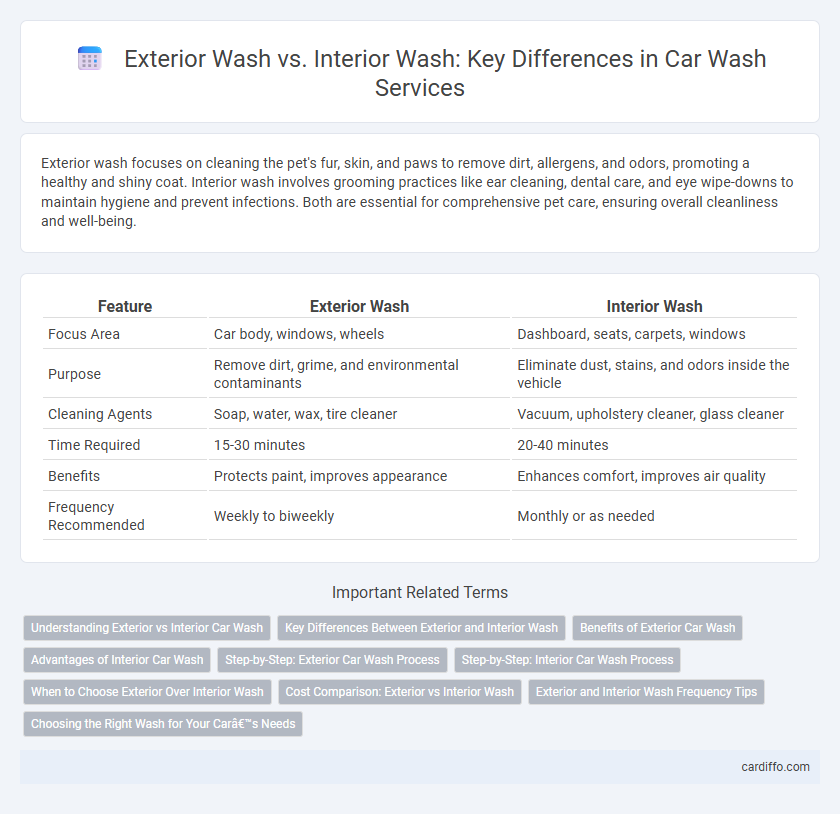Exterior wash focuses on cleaning the pet's fur, skin, and paws to remove dirt, allergens, and odors, promoting a healthy and shiny coat. Interior wash involves grooming practices like ear cleaning, dental care, and eye wipe-downs to maintain hygiene and prevent infections. Both are essential for comprehensive pet care, ensuring overall cleanliness and well-being.
Table of Comparison
| Feature | Exterior Wash | Interior Wash |
|---|---|---|
| Focus Area | Car body, windows, wheels | Dashboard, seats, carpets, windows |
| Purpose | Remove dirt, grime, and environmental contaminants | Eliminate dust, stains, and odors inside the vehicle |
| Cleaning Agents | Soap, water, wax, tire cleaner | Vacuum, upholstery cleaner, glass cleaner |
| Time Required | 15-30 minutes | 20-40 minutes |
| Benefits | Protects paint, improves appearance | Enhances comfort, improves air quality |
| Frequency Recommended | Weekly to biweekly | Monthly or as needed |
Understanding Exterior vs Interior Car Wash
Exterior car wash focuses on removing dirt, grime, and contaminants from the vehicle's outer surfaces, including the body, windows, tires, and undercarriage. Interior car wash targets the cleaning and maintenance of the cabin, addressing upholstery, carpets, dashboard, and air vents to improve air quality and appearance. Understanding the differences helps tailor maintenance routines for optimal vehicle hygiene and longevity.
Key Differences Between Exterior and Interior Wash
Exterior wash targets dirt, grime, and environmental contaminants on the vehicle's outer surfaces using specialized soaps and high-pressure water. Interior wash focuses on removing dust, stains, and odors from upholstery, carpets, and dashboard components with appropriate cleaning agents and tools like vacuum cleaners and upholstery brushes. Key differences include the cleaning methods, products used, and areas of focus, highlighting distinct approaches tailored to either the vehicle's exterior or interior maintenance.
Benefits of Exterior Car Wash
An exterior car wash effectively removes dirt, grime, and pollutants from the paint, preventing damage and maintaining the vehicle's aesthetic appeal. Regular exterior washing helps preserve the car's value by protecting the clear coat from oxidation and rust formation. This process enhances visibility by keeping windows, mirrors, and lights clean, contributing to safer driving conditions.
Advantages of Interior Car Wash
Interior car wash enhances vehicle hygiene by removing dust, allergens, and bacteria that accumulate on seats, carpets, and dashboards. It preserves the car's resale value by preventing stains, odors, and wear caused by spills and dirt buildup. Regular interior cleaning improves passenger comfort and safety by maintaining clear windows and well-maintained controls.
Step-by-Step: Exterior Car Wash Process
Begin the exterior car wash process by rinsing the vehicle thoroughly with water to remove loose dirt and debris. Apply a specialized car shampoo using a microfiber wash mitt, working from top to bottom to prevent dirt from spreading. Finish by rinsing off the soap and drying the car with a microfiber drying towel to avoid water spots and achieve a spotless shine.
Step-by-Step: Interior Car Wash Process
Interior car wash begins with thorough vacuuming of seats, carpets, and floor mats to remove dust, dirt, and debris. Next, detailed cleaning targets surfaces such as the dashboard, door panels, and vents using appropriate cleaners and microfiber cloths to eliminate grime and fingerprints. The process concludes with window cleaning and odor neutralization to ensure a fresh and spotless interior environment.
When to Choose Exterior Over Interior Wash
Choose an exterior wash when your vehicle shows visible dirt, mud, salt, or pollen accumulation primarily on the body, wheels, and windows, which can cause paint damage and rust if neglected. Exterior washes are essential after exposure to harsh weather conditions or road chemicals, ensuring the car's finish and clear coat remain protected. Opt for an interior wash only when the cabin has noticeable dust, stains, or odors affecting comfort and hygiene, while exterior washes focus on preserving the vehicle's outer appearance and longevity.
Cost Comparison: Exterior vs Interior Wash
Exterior car washes typically cost between $7 and $15, offering a budget-friendly option for routine maintenance, while interior washes range from $15 to $50, reflecting the more detailed cleaning required for upholstery and carpets. The higher price of interior washes accounts for tasks like vacuuming, stain removal, and odor treatment, which demand specialized tools and more labor time. Choosing between the two depends on budget and cleaning needs, with exterior washes providing a quick refresh and interior washes delivering a deeper clean.
Exterior and Interior Wash Frequency Tips
Exterior wash frequency depends on environmental factors such as weather, road salt, and pollution, with a recommendation of every 1-2 weeks to prevent paint damage and maintain shine. Interior wash frequency varies based on usage and exposure to dirt, with a suggested cleaning every 1-3 months to remove dust, allergens, and stains for a healthier cabin environment. Regularly scheduled exterior and interior washes extend vehicle lifespan and preserve resale value by protecting surfaces from buildup and wear.
Choosing the Right Wash for Your Car’s Needs
Selecting the right wash for your car depends on whether the focus is on maintaining the vehicle's exterior or interior condition. Exterior washes remove dirt, grime, and environmental contaminants that protect the paint and finish, while interior washes target upholstery, carpets, and dashboard surfaces to enhance comfort and hygiene. Assessing factors such as driving environment, exposure to elements, and passenger use helps determine the most suitable wash to preserve your car's appearance and value.
Exterior Wash vs Interior Wash Infographic

 cardiffo.com
cardiffo.com